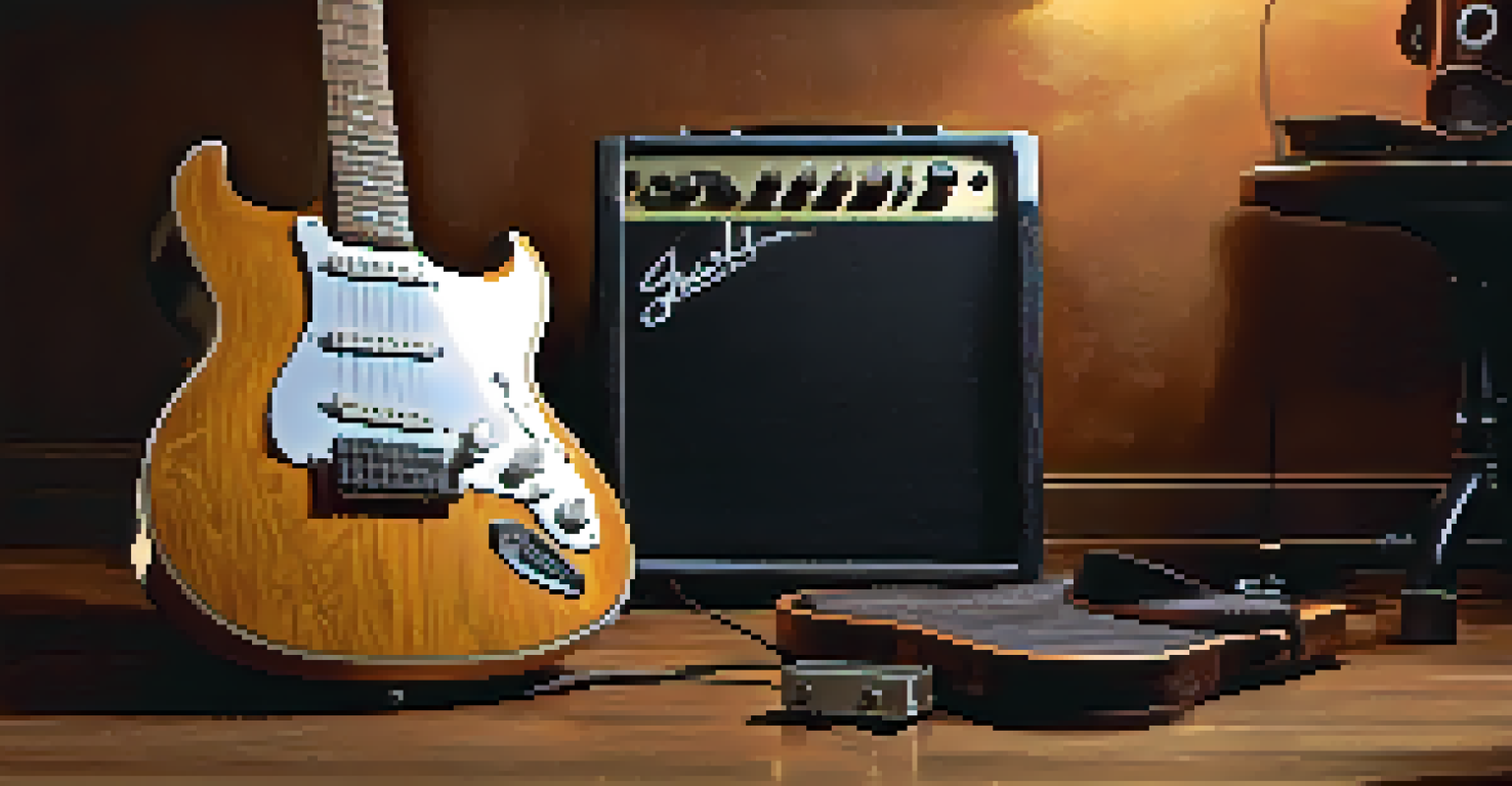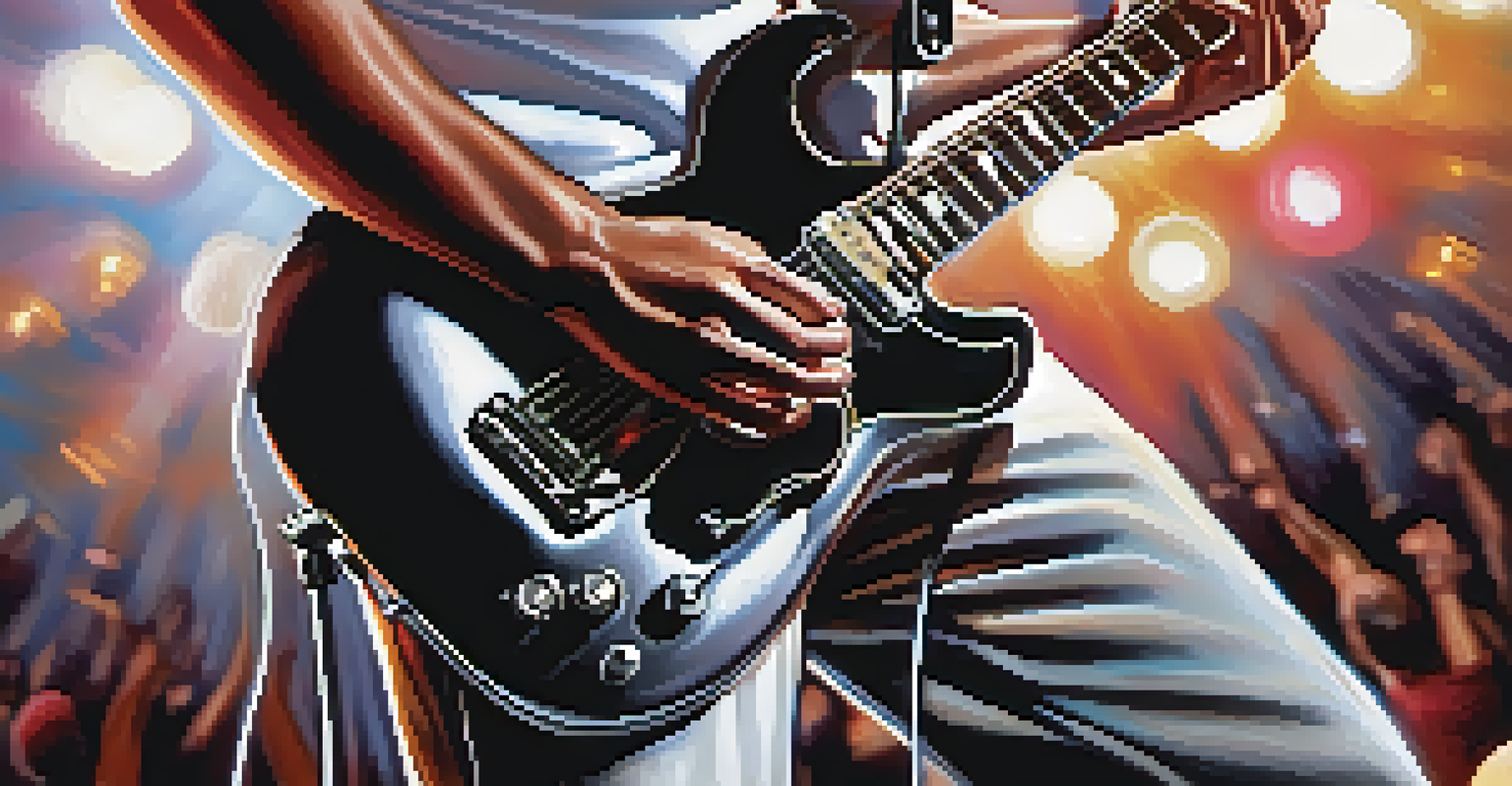The World of Distortion: Pedals That Shape Your Sound

Understanding Distortion: What Is It Really?
Distortion is more than just a sound; it's a musical effect that alters the audio signal, creating a richer, more complex tone. When you think of rock music, the raw, gritty sound often comes from distortion pedals. These pedals manipulate the waveform, adding harmonics and changing the dynamics, which can completely transform a guitar's voice.
Distortion is like a color palette for musicians, enabling them to paint their emotions through sound.
For example, when you strum a clean chord and then engage a distortion pedal, the sound can shift dramatically from clean and crisp to saturated and fierce. This change can evoke different emotions and atmospheres in a song, making distortion a powerful tool in any musician's arsenal. Whether you’re looking for a subtle warmth or a full-blown sonic assault, distortion can be your best friend.
In essence, distortion takes the familiar and pushes it to the edge, allowing artists to express themselves in unique ways. By understanding what distortion is, musicians can better harness its power and integrate it effectively into their sound.
Types of Distortion Pedals: Finding Your Flavor
Distortion pedals come in various types, each offering a unique flavor to your sound. From overdrive, which adds warmth and smoothness, to fuzz, known for its gritty, almost fuzzy texture, the options are plentiful. For instance, an overdrive pedal might be perfect for bluesy solos, while a fuzz pedal is often favored in psychedelic rock.

Additionally, there’s the classic distortion pedal, which sits somewhere in between, providing a punchy and aggressive sound that’s versatile enough for multiple genres. Understanding these distinctions can help you choose the right pedal for your musical style, whether you’re shredding metal riffs or strumming a mellow acoustic.
Understanding Distortion Effects
Distortion alters audio signals, enriching tones and enabling musicians to express emotions through sound.
The beauty of these pedals is that they can be used alone or in conjunction with one another, allowing for endless possibilities. Experimenting with different combinations can lead to discovering your signature sound that sets you apart from other musicians.
How Distortion Pedals Work: The Science Behind the Sound
At the heart of distortion pedals is a fascinating interplay of electronics that manipulates the audio signal. When you engage a distortion pedal, it clips the audio waveform, which is where the magic happens. This clipping process adds harmonics and alters the dynamics, essentially reshaping how the sound waves interact with each other.
Music is the shorthand of emotion.
To visualize this, think of a wave in the ocean: when it rolls in smoothly, it’s calm and gentle. But when it crashes against the shore, it’s chaotic and powerful. That’s similar to what distortion does to your sound—it takes a smooth audio signal and transforms it into something full of character and intensity.
Moreover, different pedals utilize various components, such as transistors or diodes, to achieve their distinctive sounds. By understanding the underlying technology, musicians can make more informed choices about which pedals will best suit their creative vision.
The Emotional Impact of Distortion in Music
Distortion isn't just about altering sound; it’s about evoking emotions. Think about how the gritty sound of a distorted guitar can stir feelings of rebellion or urgency. Many iconic songs leverage distortion to create a mood that resonates deeply with listeners, making it an essential element of musical storytelling.
For instance, consider the electrifying riffs of classic rock anthems or the haunting tones in some alternative tracks. Each note, when distorted, carries weight and intensity, capturing the listener's attention in a way that clean tones might not. This emotional connection is why musicians often turn to distortion to amplify their expression.
Choosing the Right Pedal
With various types of distortion pedals available, selecting the right one depends on your musical style and desired sound.
Ultimately, distortion can serve as a bridge between the artist's intent and the audience's experience. By skillfully using distortion, musicians can create a soundscape that draws listeners in, making them feel every note and lyric.
Famous Songs That Showcase Distortion Pedals
Many legendary songs have prominently featured distortion pedals, showcasing their transformative power. For instance, Nirvana’s “Smells Like Teen Spirit” features a raw, distorted guitar riff that became instantly recognizable and influential in the grunge movement. This song's success hinged on the gritty sound that distortion provided, capturing the angst of a generation.
Similarly, Jimi Hendrix’s use of distortion in tracks like “Purple Haze” created an otherworldly sound that pushed the boundaries of music at the time. His innovative approach demonstrated how distortion could be used to create textures and layers, making each performance a unique sonic experience.
These examples illustrate not just the versatility of distortion pedals but also their ability to define genres and eras in music. When you listen closely, you can hear how distortion shapes not just sound, but the very essence of songs that have become timeless classics.
Tips for Choosing the Right Distortion Pedal
Choosing the right distortion pedal can feel overwhelming with so many options on the market. Start by considering your musical style and the sound you want to achieve. For instance, if you’re into classic rock, an overdrive pedal might work wonders, while metal enthusiasts might lean toward high-gain distortion pedals.
Don’t forget about the importance of trying out pedals before buying. Head to a local music store and test different pedals with your own guitar to see how they interact. Pay attention to how responsive each pedal is to your playing dynamics, as this can greatly influence your overall sound.
Maintaining Your Distortion Pedal
Proper care, including cleaning and using the correct power supply, ensures your distortion pedal performs optimally for years.
Lastly, consider your budget and remember that more expensive doesn’t always mean better. There are plenty of affordable options that can deliver fantastic sounds. Finding a pedal that resonates with your style and fits within your budget can lead to incredible creative possibilities.
Caring for Your Distortion Pedals: Maintenance Tips
Once you’ve found the perfect distortion pedal, it’s essential to take care of it to ensure longevity and optimal performance. Start by keeping it clean—dust and dirt can accumulate and affect the circuitry. A simple wipe down with a microfiber cloth can go a long way in maintaining its appearance and function.
Additionally, be mindful of your pedal’s power supply. Using the wrong adapter can damage the pedal, so always double-check compatibility. Investing in a power supply with multiple outputs can help you manage several pedals without risking any electrical issues.

Finally, consider using a pedalboard to organize and protect your pedals during transport. A sturdy pedalboard can help avoid accidental damage and keep your setup neat and efficient. With a little care and attention, your distortion pedals can provide years of sonic creativity.